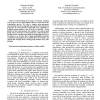Free Online Productivity Tools
i2Speak
i2Symbol
i2OCR
iTex2Img
iWeb2Print
iWeb2Shot
i2Type
iPdf2Split
iPdf2Merge
i2Bopomofo
i2Arabic
i2Style
i2Image
i2PDF
iLatex2Rtf
Sci2ools
110
click to vote
CSE
2009
IEEE
2009
IEEE
Representing Small Group Evolution
: Understanding the dynamics of network evolution rests in part on the representation chosen to characterize the evolutionary process. We offer a simple, three-parameter representation based on subgraphs that capture three important properties of social networks: leadership, team alignment or bonding among members, and diversity of expertise. When plotted on this representation, the evolution of a typical small group such as start-ups or street gangs has a spiral trajectory, moving toward a tentative fixed point as membership increases to two dozen or so. We show that a simple probabilistic model for recruitment and bonding can not explain these observations, and suggest that strategic moves among group members may come into play. Social networks, small groups, dynamics, evolution, models
CSE 2009 | Network Evolution Rests | Small Groups | Social Networks | Theoretical Computer Science |
Related Content
| Added | 09 Nov 2010 |
| Updated | 09 Nov 2010 |
| Type | Conference |
| Year | 2009 |
| Where | CSE |
| Authors | Whitman Richards, Nicholas C. Wormald |
Comments (0)

